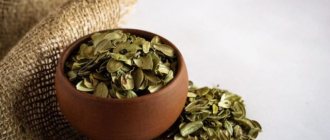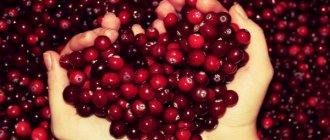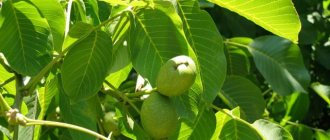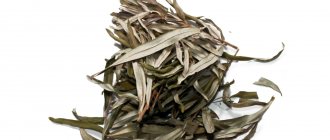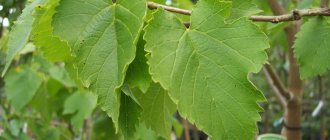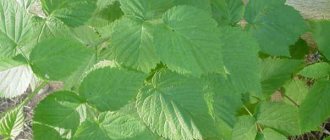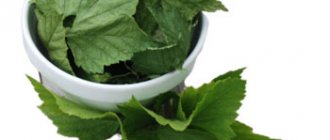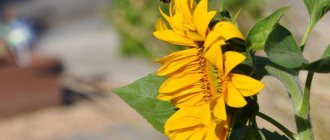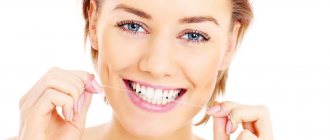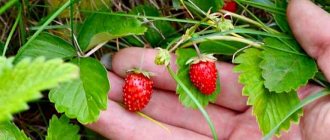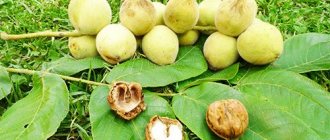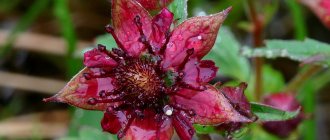Release form and composition
Dosage forms of release of Lingonberry leaves:
- crushed leaves: pieces of leathery leaves of various shapes that pass through a sieve with 3 mm holes, odorless, the color of the leaves on one side is dark green, on the other light green with clearly visible dark brown dots; the taste of the water extract is astringent, bitter (in paper polypropylene or plastic bags of 25, 50, 75 or 100 g, in a cardboard pack 1 bag);
- crushed vegetable raw materials: pieces of petioles and leaves of various shapes, odorless, color – grayish-green with rare brown, pinkish-violet or violet-brown inclusions; the taste of the water extract is astringent, bitter (in polypropylene or paper bags of 30, 35, 40, 50, 60, 75 or 100 g, 1 bag in a cardboard pack);
- leaves-powder (vegetable raw materials-powder): pieces of leaves of various shapes that pass through a sieve with 2 mm holes, odorless, color – grayish-green with rare brown, pinkish-violet or violet-brown inclusions; the taste of the water extract is astringent, bitter (in filter bags of 1.5 g, in a cardboard pack there are 10, 20, 24, 30 or 50 filter bags; in filter bags of 2 g, in a cardboard pack there are 10 or 20 filter bags) bags).
Active ingredient: lingonberry leaves – 100%.
Beneficial properties of lingonberry leaf decoction
A drink made from lingonberries is popular among traditional healers and herbalists. It is used:
- antipyretics;
- anthelmintic;
- diuretics;
- antiseptic and bactericidal properties.
Academic medicine prepares diuretic, choleretic, and disinfectant drugs from the decoction. Pharmacies sell ready-made collections of dried plants and berry syrup.
It is recommended to supplement drug therapy with a decoction of lingonberry leaves:
- prostatitis;
- gastritis;
- rheumatism, arthritis, gout;
- cystitis;
- pyelonephritis;
- liver ailments;
- periodontal disease and stomatitis;
- nephropathy and pyelonephritis in pregnant women;
- purulent kidney infection;
- urolithiasis;
- inflammatory pathology of the respiratory tract;
- colds;
- osteochondrosis;
- hypertensive conditions;
- disorders of the gastrointestinal tract, accompanied by bloating, constipation, flatulence;
- tonsillitis;
- chronic fatigue;
- diabetes mellitus;
- vitamin deficiency
In addition, the drink is recommended to drink for sleep disorders and pregnant women. Depending on the type and form of the pathology, as well as the physical characteristics of the person, the decoction is prepared according to one recipe or another. Both fresh and dried raw materials are used to make the drug.
It is important to remember that a decoction of lingonberry leaves has a pronounced effect. This explains the recommendation that for those who decide to use the drink themselves, first make sure that there is no allergic reaction to the chemical elements present in it. If this is not done, then you can provoke nausea, vomiting, and loss of consciousness. Violation of the cooking recipe leads to the same consequences.
We advise you to read: Decoction for alcoholism
Pharmacological properties
Pharmacodynamics
The drug is characterized by a complex (antimicrobial, demineralizing, astringent, choleretic, diuretic, anti-inflammatory) effect. It is active against Staphylococcus aureus. The medicinal properties of lingonberry leaves are due to the active components contained in them, which include hyperoside, arbutin, tannin, vaccinin, ursulic, tartaric, gallic, quinic and ellagic acids, lycopene, hydroquinone, glycosides and various micro- and macroelements.
The drug increases the effectiveness of antibacterial drugs, takes part in the regulation of nitrogen metabolism and stimulates the body's immune system (phagocytosis).
The diuretic effect is explained by the presence of arbutin in the composition of this herbal remedy, which turns into free hydroquinone, which irritates the kidney tissue and increases urine output. Increased diuresis also provides hyperoside, which undergoes hydrolysis in the body to form quercetin. During the metabolism of the vaccinin glycoside, benzoic acid is synthesized, which has a pronounced antimicrobial effect. It also promotes disinfection of the urinary tract and alleviates the patient’s condition with gout, rheumatism, urinary and cholelithiasis.
Pharmacokinetics
There is no information on the pharmacokinetics of the drug.
Who are lingonberry leaves contraindicated for?
A decoction of lingonberry leaves removes calcium from the body, so during treatment it is necessary to monitor the condition of the teeth. If you have dental problems, it is better to refrain from such a prescription. Other medical contraindications:
- myocardial pathologies with heart rhythm disturbances;
- gastric bleeding, gastric and duodenal ulcers;
- gastritis with high acidity;
- varicose veins, impaired blood clotting;
- arterial hypotension;
- acute renal failure;
- cholecystitis;
- age under 18 years;
- breast-feeding;
- individual intolerance to the components of the medicinal plant;
- internal bleeding and predisposition to it.
Article on the topic: Aspiration pneumonia - treatment in adults and children
Can I take it during pregnancy?
When treating pregnant women with lingonberry leaves, you need to consult a specialist. Infusions and decoctions on this basis increase the tone of the uterus, so the threat of miscarriage increases. Medicines with lingonberry leaves can be taken by pregnant women with diabetes. Daily doses are adjusted individually. It is important to follow the prescribed dosages and not self-medicate. Gynecologist's recommendations:
- You can drink the decoction in the third trimester of pregnancy for swelling of the legs and arms.
- Infusion and tea help with symptoms of toxicosis. They prevent nausea and vomiting.
- During lactation, this prescription is contraindicated, since the components of the plant are excreted in breast milk. The baby may develop allergies.
Instructions for use of Lingonberry leaves: method and dosage
Lingonberry leaves are taken orally as a water infusion, preferably 40 minutes after meals.
Cooking method:
- crushed leaves, crushed vegetable raw materials: 1 tablespoon (about 6 g) of raw materials is poured into 1 glass (200 ml) of hot boiled water (in an enamel bowl) and infused under a closed lid in a boiling water bath, after 30 minutes, without cooling, filter and squeeze out the remaining raw materials; the volume of infusion must be brought to the original volume with boiled water;
- leaves-powder: 2 filter bags are poured with 100 ml (1/2 cup) boiling water (in a glass/enamel bowl) and infused under a lid; Periodically press down on the bags with a spoon. After 30 minutes, squeeze out the bags. The volume of infusion must be brought to the original volume with boiled water.
Recommended dosage regimen: 3 to 4 times a day, 1–2 tablespoons for a course of 20 to 25 days. The doctor may prescribe a second dose of the drug after 10–12 days. Maximum – 4 courses per year.
It is recommended to shake the decoction before use.
Healthy recipes with lingonberry leaves
How to brew lingonberry leaves
The leaves are crushed as finely as possible, take four teaspoons per half liter of boiling water, keep in a thermos for half an hour, leave until cool, and drain. Take a quarter glass.
Classic decoction recipe
Heat two tablespoons of leaf and a glass of boiling water over low heat for half an hour. The cooled product is filtered and added to a glass. How to take lingonberry leaf - drink a third of a glass three times a day before eating. It can be stored for no more than two days.
On the mineral
A decoction with mineral water is prepared in the same way as with ordinary water, but is left to steep for 48 hours. Consume strictly after meals, half an hour later, for all the health problems listed above.
Branches and leaves
A spoonful of the mixture, 200 ml of boiling water, infuse for 30 minutes, filter. Lingonberry leaves are drunk up to five times a day for swelling and other diseases.
Leaf tea
An excellent tasty remedy for the treatment of the genitourinary system, female diseases, gastritis. For a glass of boiling liquid you will need a teaspoon. Drink half a glass before meals.
Whole plant decoction
Use the entire above-ground part plucked during flowering. Fifty grams, 400 ml of boiling water are infused for twenty minutes. Take 1/4 cup after meals.
Healing Possibilities
Petals are not inferior to berries in terms of vitamins and minerals. The healing herb of this plant has the following medicinal properties:
for inflammatory diseases of the kidneys and bladder;- to remove swelling during complex therapy for hypertensive patients;
- for varicose veins to strengthen the walls of capillaries and reduce swelling;
- to prevent rheumatic pain;
- in diabetes with tissue damage, as symptomatic therapy, strengthening vascular walls, lowering blood sugar.
A decoction of lingonberry petals can be consumed as regular tea or as an auxiliary drug:
- to remove urea and reduce swelling of the hands and feet;
- to relieve inflammation in joints due to gout and stop chronic destructive effects;
- for cystitis and other diseases that are accompanied by inflammatory processes;
- from parasites and fungi, as well as to reduce the impact of herpes;
- for viral diseases of the respiratory tract, for gargling;
- in the treatment and prevention of diabetes mellitus;
- for gastritis, enterocolitis: use a decoction of 100 ml twice a day or one tablespoon four times a day.
To prepare the decoction you need to take 1 tbsp. l. dry, crushed leaves and 250 ml of clean water, simmer them over low heat for half an hour. After the brew has cooled, strain and squeeze out the remainder, bringing the volume of liquid to the original level.
You can brew lingonberry leaves in any way, it all depends on what disease you want to cure.
Lingonberry leaf - beneficial properties, main medicinal properties
In general, due to the content of a whole complex of useful vitamins and minerals in its leaves, lingonberry has a general positive effect on the body (with the exception of rare cases associated with possible contraindications), having a beneficial effect on most organs and all body systems. What specific beneficial properties do the leaves of this plant have:
✔ They have a certain antibacterial effect and increase to some extent the effectiveness of bactericidal drugs, in particular antibiotics.
✔ They have a pronounced antipyretic effect, which can be used in the treatment of many ailments, including colds, viral infections, and so on.
✔ They help maintain glucose levels in a person’s blood, which, in turn, is an effective preventive measure against the development of diabetes. This allows those people who have already encountered this insidious disease to feel better.
✔ They exhibit antiviral and antifungal effects. This property of lingonberry leaf opens up the possibility of its use not only as an internal remedy, but also for external use.
✔ They increase the level of defenses of the human body, providing a general strengthening effect on it. This is especially true with the onset of cold weather, when the level of colds and viral diseases increases significantly, as well as in the spring, when it continues to hold its position due to weather conditions (everyone is in a hurry to take off their hats, despite the danger of catching a cold) and the depletion of the body’s reserves of nutrients needed for its normal harmonious functioning. Products from lingonberry leaves allow you to partially replenish these reserves.
✔ They have a pronounced astringent effect, which, again, expands the range of their use from internal to external. Indeed, thanks to it, lingonberry leaves (more precisely, preparations prepared on their basis) can be used both to stop bleeding, heal wounds, and, for example, to get rid of diarrhea.
✔ They affect the water-salt balance of the body as a rather strong diuretic. This makes it possible to use lingonberry remedies for edema, hypertension, and various ailments of the bladder and kidneys.
✔ They have a positive effect on the condition of the gastrointestinal tract, improving intestinal motility, eliminating inflammation in it, exhibiting a choleretic effect, allowing to neutralize stagnation of bile in the gallbladder and, thereby, avoid the formation of stones in it, and also optimize its “interaction” with the liver , thereby protecting her and improving, among other things, her condition.
✔ They perfectly tone up, giving a boost of energy for several hours ahead. In order to feel a surge of vital energy, as recent studies show, it is not necessary to drink coffee.
Try replacing it with a cup of aromatic healing tea made from lingonberry leaves. It's much more useful! You will be very, very pleasantly surprised by the result.
Recipes for medicinal decoctions
We bring to your attention several recipes that can be easily prepared at home.
How to prepare a decoction of lingonberry leaves for the treatment of osteochondrosis
The drink is used as an anti-inflammatory and antirheumatic agent. To prepare it, pour 250 ml of hot water into a vessel with one tablespoon of leaves. Bring to a boil, leave for an hour. Take 100 ml morning and evening.
To lower blood pressure
For hypertension and hypertension, take a drink made from dried leaves. You can buy ready-made ones at the pharmacy or assemble them yourself. Cooking algorithm:
- Place 10 dry leaves in a bowl for boiling;
- add 0.4 liters of boiled water there;
- bring the mixture to a boil, and reduce the heat under the container to a minimum;
- cook for 15 minutes;
- The finished decoction still needs to be left to steep for three hours.
For twenty-one days, drink a quarter glass before breakfast, lunch, and dinner.
How to prepare a decoction of lingonberries to treat rheumatoid arthritis
Dry leaves must be ground into powder. To do this, use a coffee grinder or hand mill. Then the crushed lingonberry leaves, which fit in one teaspoon, are poured with a full glass of boiled water. Bring the mixture to a boil, simmer over low heat for about seven minutes.
The hot mixture is filtered into a clean container and cooled at room temperature. Take small portions throughout the day. The next day, prepare a fresh decoction.
We treat prostatitis
Grind the dry leaves of the plant to form ground coffee, measure out 3 tablespoons of powder. Fill with filtered and boiled glass of water. Using a water bath, heat the solution for 15 minutes without bringing it to a boil.
After it has cooled, clear the suspension with gauze so that you can squeeze out the undissolved substance. An hour before breakfast and dinner you should take one teaspoon. Store the decoction in the refrigerator.
Lingonberry decoction during pregnancy and breastfeeding
With the help of this drink, a pregnant woman or a nursing mother can get rid of colds, swelling, and inflammation of the urinary tract without resorting to medications. Lingonberry leaves are one of the components of the drug "Canephron", which is often prescribed to pregnant and lactating women.
We advise you to read: Sage decoction
In addition, under the influence of the decoction, hemoglobin levels are normalized. But you must take the drug strictly following the dosage prescribed by your doctor. The fact is that the tonic property of the plant can provoke uterine contractions.
Taking the drug by a nursing mother ensures that the baby receives vitamins. If the doctor has not prescribed a special course, then the remedy is taken three times a day, one third of a glass. And to prepare it, pour 50 g of dried leaves with 0.2 ml of boiling water. Bring to a boil and immediately remove from the stove. Cool and strain.
The benefits of lingonberry decoction for swelling
Using this drink made from leaves containing vitamin P can effectively get rid of puffiness. Recipe:
- We take the dried raw materials, grind them and measure out 2 tbsp. l., which we place in a saucepan.
- Pour one two hundred and fifty gram glass of hot water there.
- Let the solution boil, remove it and wrap it in a warm cloth for two days.
You should take the decoction in the morning and evening, one tablespoon at a time.
A decoction prepared according to the same recipe is used for compresses to help relieve swelling under the eyes. To do this, cotton pads soaked in the solution are applied to the problem area of the face for 15 minutes. The course of treatment is 2 weeks.
One recipe used to treat several diseases at once
A decoction prepared according to this recipe helps with several diseases. The quantity per dose and the frequency of daily doses differ. Recipe:
- Pour one tablespoon of dried leaves, placed in a clean container, with one glass of boiling water.
- We put it on the fire and let it boil, after which we reduce the combustion to a minimum and simmer the drug for half an hour.
The cooled and strained broth is taken as follows:
- if there are problems with the urinary system, then 100 ml, waiting 30 minutes after eating, but at least three times during the day;
- for pyelonephritis, the same amount, the same number of times, but an hour before meals;
- to treat colds, take half a glass 3 times a day no later than twenty minutes before breakfast, lunch, dinner.
To get rid of a cold, you can also use a decoction, which is prepared as follows:
- to pour two tablespoons of lingonberry leaves you will need a container and half a liter of unboiled water;
- put the dishes on the fire and bring the broth to a boil, but do not let it boil, simmering it in the minimum heat mode for twenty minutes;
- remove the suspension by passing through gauze.
We advise you to read: Decoction of birch leaves
The patient needs to drink two tablespoons of warm broth, but not before meals, as in the previous case, but after 40 minutes.
Decoction of leaves for urinary incontinence at night
A person suffering from enuresis experiences spontaneous leakage of urine. Often a similar problem appears in adulthood with severe inflammation of the urinary tract. And in men with prostatitis in combination with cystitis or urethritis.
In this case, there is no urge to urinate, and 2-3 hours after falling asleep, urine flows out spontaneously. Drug therapy and a decoction of lingonberry leaves will help get rid of this unpleasant disease.
In addition to the main component (one tablespoon of lingonberry leaves), you will need the same amount of berries of the plant, twice as much dry St. John's wort. Pour this entire mixture into three glasses of water and put it on fire.
Let the solution boil, keep on fire for 10 minutes. The resulting amount of finished decoction is divided into 3 parts, the first of which is drunk at 16:00, and the last - before going to bed. In the interval between these receptions, the third part is drunk.
Diuretic properties of lingonberries
As a diuretic, this plant can be used in the form of roots, leaves and fruits. The most effective and safe remedy against fluid retention in the body is considered to be lingonberry juice, which is often prescribed to pregnant women for swelling, since medications are often too harmful and dangerous for the health of the expectant mother and child.
The most powerful effect of all plants is the lingonberry leaf, from which tinctures and decoctions are made. Herbal teas made from such leaves are freely available in pharmacies, and you can also prepare them yourself. E
There are some nuances of plant collection that should be studied. In particular, the leaves are collected in the spring before the buds open, and also in the fall, as soon as the fruits are collected. In summer, lingonberry leaves are not harvested because they lose their healing properties and darken. All raw materials are listened to in a darkened room with good ventilation. The leaves can also be dried in a low-heat oven.
More on the topic: Diuretic plum or not?
The shrubs of this plant accumulate hazardous substances contained in the soil and air, which is why it is necessary to carefully choose a collection site. It should be located away from production areas, factories and factories, as well as landfills and highways.
Lingonberry has not only a diuretic effect, but also an antiseptic, immunomodulatory and antimicrobial effect. That is why it is used in the treatment of most genitourinary diseases. Before you start taking herbal remedies, you should get a recommendation from your doctor and be tested for allergies.
